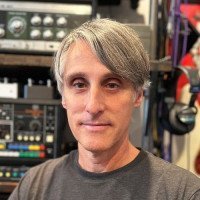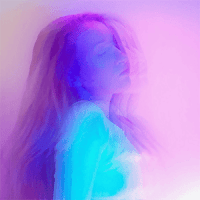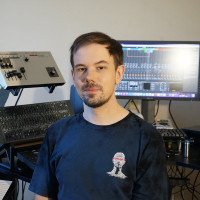Dream Machine










Chosen by MusicRadar Readers as the Best Software Synthesizer of 2022!
GX-80 is a transformative virtual synthesizer that combines the unparalleled sound and features of the fabled GX-1 “Dream Machine” and its renowned descendant the CS-80, to create a powerhouse hybrid. Featuring the carefully crafted and intensely circuit-modeled DSP designs of award-winning developer Mark Barton, Cherry Audio has replicated every subtlety of the classics to create the most authentic emulation of its kind.
GX-80 is not just another CS-80 emulation. GX-80 adeptly integrates the GX-1's distinctive feature set into the CS-80 architecture; most significantly, the massive dual-layer architecture that effectively made the GX-1 the equivalent of two CS-80s and then some. The GX-1's unique highpassed resonant pulse and bandpassed sawtooth waves, octave-up triangle wave, and filter envelope inversion are incorporated, opening up a new universe of sonic experimentation. Most notably, GX-80 includes an expert reproduction of the legendary GX-1 filter, delivering exquisite timbres that even the mighty CS-80 cannot produce.
GX-80 boasts an impressive, dual-layer voicing architecture outfitted with 16 polyphonic voices per layer. The instrument is capable of sounding two different CS-80 style sounds simultaneously, while panning each rank independently, to produce exquisitely rich stereo timbres and complex, layered sounds. For ultimate flexibility and expressive performance, GX-80 provides a split keyboard mode and a clever option to simulate polyphonic aftertouch with a monophonic aftertouch controller. What’s more, the GX-80 comes pre-loaded with over 1,000 expertly designed presets and equipped with studio-grade effects, meaning jaw-dropping sounds are no more than a few clicks away.
GX-80 is more than a best-of-both-worlds interpretation of the past, and far more than a replicant. Cherry Audio's GX-80 is an unprecedented gateway to the sounds and music of an unrealized future.

In 1973, the most technologically advanced polyphonic synthesizer ever conceived was released. Featuring groundbreaking advances in polyphony, velocity and aftertouch sensitivity, along with four ranks of incredible sound quality, the GX-1 was a quantum leap forward from its contemporaries. It was produced in extremely limited numbers (estimated at around 20) and cost $50,000. As a result of its immense size, weight, and price tag, The Dream Machine, as it was known, was available only to the most well-heeled professional musicians. Only a handful of these instruments survive today. Notable users of the GX-1 and tracks featuring it included Keith Emerson ("Fanfare for the Common Man"), Stevie Wonder ("Village Ghetto Land"), ABBA ("Lay All Your Love on Me"), and John Paul Jones of Led Zeppelin ("All My Love").
Four years later, in 1977, the more programmable CS-80 synthesizer was released. More compact and affordable, owing to a single keyboard and two ranks, the CS-80 retained the same basic voicing architecture and innovative real-time performance control capabilities as the GX-1. The CS-80 was embraced by music professionals, including Paul McCartney, Eddie Jobson, Michael Jackson, Peter Gabriel, Hans Zimmer, and Vangelis, who famously made use of its highly expressive real-time performance capabilities in Ridley Scott's 1982 sci-fi classic, "Blade Runner."
Though their outward appearances were radically different, the GX-1 and the CS-80 instruments were very similar under the hood. Both featured a voicing architecture based on "ranks," wherein each rank was a complete synthesizer voice consisting of an oscillator, highpass and lowpass filters, a noise generator, a sine wave oscillator, a VCA, and envelope generators for both the filter and VCA. The CS-80 included two of these voice ranks, each capable of playing up to eight independent polyphonic notes -- a total of 16 synth voices under the hood. The GX-1 featured four of these eight-note poly voice ranks, assignable across two keyboards, plus a single solo synth voice rank for its three-octave mini keyboard and another synth voice rank for the pedalboard.
Unlike the CS-80, the GX-1 was strictly a preset instrument. Though it had no onboard synthesizer parameter controls, its analog synthesizer voicing could only be programmed using an external hardware programmer box through a very elaborate procedure.

On the other hand, the GX-1 had several tricks up its sleeve that were not passed on to the CS-80. The GX-1 oscillator section featured a pulse wave with an adjustable highpass resonator and a sawtooth wave with a dedicated bandpass resonator, in addition to and in parallel with the standard pulse and sawtooth wave outputs. Additionally, it had an adjustable octave-up triangle wave, a filter envelope inversion option, and a VCF comprised of highpass and lowpass filters with such immense range that they are still considered legendary to this day.
A virtual reproduction of the CS-80 has long been the most popular request from Cherry Audio fans. The company began work in 2021 to make the dream a reality. DSP designer and developer Mark Barton's extensive research of the original CS-80 and its schematics led him back to the CS-80's predecessor, the indomitable GX-1.
"The CS-80 was loathe to give up all its secrets," says Mark Barton, whose work on deciphering its audio path was exemplary. "As soon as we found something we thought strange, we immediately verified the behavior on both CS-80s we used for modeling. We then did a deep dive into the schematics to verify why we were hearing what we were hearing."
As a result, GX-80 combines all of the sonic characteristics of the originals with exceptional accuracy. When enhanced with GX-80's discrete layer volume and panning controls, the result is a colossal dual-layer voicing architecture, 16 polyphonic voices per layer, with two different timbres simultaneously playable in a split or stacked layer mode.
But Cherry Audio didn't stop with the extraordinary sound, as the originals were also revered for their magnificent, expressive performance features. To provide an experience as close as possible to the original hardware, GX-80 adds a split keyboard mode and support for both polyphonic and monophonic aftertouch controllers. Further, Cherry Audio has added an innovative "last-note priority" mode for simulated poly aftertouch response with a monophonic channel aftertouch controller.
With its dual-layer interface and multithreaded processing, over 1,000 stunning presets, and integrated studio-quality effects, GX-80 is a singular effort worthy of the "flagship" label.
At last count, only a dozen operating GX-1s have been accounted for, and used CS-80s are rarely listed for less than $60,000. The rarity and exorbitant cost of both instruments has made it impossible for musicians to experience these legendary instruments. That's why Cherry Audio is making its flagship GX-80 synthesizer available at an astoundingly low price that anyone can afford: only $59!
GX-80 is also available as part of Cherry Audio's new and comprehensive Synth Stack 4 collection, which features all of its virtual instruments to date at an even more astonishingly affordable price.
Cherry Audio and Tim Shoebridge have again teamed up for another of their overwhelmingly popular introductory videos to get users up and running, this time on the magnificent GX-80.
Music Player Network has created a dedicated MPN GearLab thread featuring their independent and interactive review of GX-80 as an ongoing community space for focused discussion of this flagship synthesizer. Find out what some of the most experienced gear specialists in the industry have to say about GX-80, and join in the conversation!
Find immediate inspiration in GX-80's extensive preset library, created by a wildly talented and diverse group of sound designers, led by veteran sound designer James Terris.

James is Director of Sound Design, responsible for preset programming and curation at Cherry Audio. He is a long-established sound designer and musician based in the San Francisco Bay Area who has worked with Dave Smith Instruments/Sequential, Pioneer DJ, Apple, and Hans Zimmer’s Remote Control.

Drew Schlesinger began developing third-party sounds for Casio CZ synths in 1986, leading to a career designing presets for over 200 products from 30 companies including Roland, Korg, Kurzweil, Alesis, E-mu, Ensoniq, TC, Lexicon, Eventide, and others. After a 20-year hiatus in the corporate world, he has recently returned to music and sound design.

Mike Martin is an accomplished musician, sound designer, and music industry product manager. An alumnus of the Conservatory of Music at Capital University, he has worked in the music industry for more than 25 years and has held positions at Casio Music, Sonic Foundry, Kurzweil Music Systems, Yamaha, and TC Electronic.

Julie Kathryn (I AM SNOW ANGEL) is a recording artist, multi-instrumentalist, producer, and sound designer. She has developed a signature dreampop aesthetic as I AM SNOW ANGEL. She regularly designs MIDI presets for Ableton Live and has created audio sound packs for Splice and BandLab.

Veteran sound designer, producer, film composer, and podcaster. Huston has contributed sounds to an endless array of popular products by Toontrack, Izotope, Synthogy, Kilohearts, Roland, Alesis, Spectrasonics, and Sequential.

Matia (INHALT) Simovich has shared his unique sound design skills with various leading musical instrument manufacturers such as Sequential/Dave Smith Instruments, Akai Professional, Elektron, and more. He has collaborated with Peter Baumann (Tangerine Dream), and produced Body of Light’s Billboard charting LP “Time to Kill."

James is a freelance sound designer and musician based in the UK. He creates third-party preset packs as JD Soundsets. He draws inspiration and influence from Tangerine Dream, 80s film scores, and others and has been a long-time sound designer for Cherry Audio, Modal, and IK Multimedia.

Katharine Fountain aka FOUNTAINS is an artist, producer, and sound designer based in Nova Scotia, Canada. Katharine graduated from Berklee College of Music in 2019. In addition to freelance sound design work, Katharine also releases music under her self-produced solo electronic pop project, FOUNTAINS.

Darrick Atwater (Agent Method) is a sound designer, producer, engineer and a comedic content creator in the Metro Atlanta area. He pulls influence from genres of the early aughts and combines them with dubstep, future bass/trap EDM, and vaporwave. He creates content and sounds for major audio companies and is building his own effects and plugins.

Christian has worked with some of the biggest names in the industry as a musician and producer. He is best known for his enthusiastic and soulful playing style and uncanny ability to sound design classic and modern sounds. His company, SOUNDS FAMOUS, recreates iconic patches, samples and sounds from famous records and artists.

Sound designer, music producer, and songwriter. Dave has crafted sounds for major artists including Michael Jackson, The Cure, Bonnie Raitt, and Fleetwood Mac. He has created thousands of factory presets for synthesizer giants including Yamaha, Korg, Roland, and Dave Smith Instruments.

Jordan Passmore is an electronic musician known for techno and house music production with analog synthesizers and vintage drum machines. He is an active creator and performer, releasing hundreds of tracks and videos, and has partnered with synthesizer brands to create content featuring music produced with their instruments.
A best-in-class virtual instrument based on two monumental analog classics: the GX-1 and CS-80
Integrates the extended features of the GX-1 with all of the functionality of its descendant, the CS-80, for an absolutely immense sound experience; essentially, two CS-80s and more!
Massive dual-layer voicing architecture with 16 polyphonic voices per layer: two different CS-80 style sounds simultaneously playable, in either a keyboard split or stacked layer mode, with discrete controls for layer volume and panning
All GX-1 and CS-80 voicing parameters reproduced, including the GX-1's unique oscillator-level filtered waveforms, octave-up triangle wave, and invert filter envelope control
Precision recreation of both the legendary CS-80 and unmatched GX-1 filters
Four polyphonic voice ranks, each with a voltage-controller oscillator, resonant highpass and lowpass filters, noise generator, sine wave, dual envelope generators, and a velocity-sensitive VCA
Sub oscillator LFO for each layer with sine, sawtooth, ramp, square, sample and hold, and noise intended for modulation, with tempo sync
Recreation of the memorable CS ring modulator that modulates the summed output of each pair of ranks with its own independent oscillator
Coarse pitch range setting for each oscillator in traditional organ footage of 16', 8', 5 1/3', 4', 2 2/3' and 2', as well as the 3 1/5' and 2 2/7' footages exclusive to the GX-1
Virtual pitch ribbon controller precisely modeled on the actual behavior of the original
GX-1 specific controls clearly distinguished from standard CS-80 control parameters
Independent rank panning and independent layer stereo effects chain for expansive and breathtaking stereo tones
Tone Selector includes each of the original CS-80 factory presets plus user sound storage
Panel Control for selecting layers, with a utility function for exchanging settings between ranks in a layer, the Lower and Upper sound layers, or even between presets
Over 1,000 essential presets that make the most of every unique aspect of the GX-80, crafted by a talented and diverse group of sound design veterans
Studio-quality integrated effects: chorus/rotary, flange/phaser, digital/tape delay with sync, and reverb, including our acclaimed "Galactic" reverb algorithm, with global or dual layer modes
Expressive touch response worthy of the originals: velocity sensitive with support for both polyphonic and monophonic aftertouch, plus a unique "last-note priority" mode for simulated polyphonic aftertouch response
Complete MIDI control and DAW automation for all controls, with easy-to-use MIDI learn and mapping (Preset and Global)
Cherry Audio's popular Focus zoom-in feature, as well as standard UI zoom and resize with drag
Highly optimized coding for optimal performance with ultra-low CPU load
NEW! Highly optimized multithreaded processing for presets using Dual and Split Layer modes
User-adjustable oversampling control
GX-80 is available in AU, VST, VST3, AAX, and standalone formats.
A free 30-day demo of GX-80 is available. This demo will play white noise periodically, but is otherwise unlimited.
macOS Requirements: macOS 10.13 or above. macOS 13 Ventura supported. 64-bit required. Native Apple M1 or greater processor support, including Ultra. 3.4 GHz Quad-Core or M1 CPU with 8GB of RAM recommended.
Windows Requirements: Windows 7 or above (including Windows 11), 64-bit required. 3.4 GHz Quad-Core computer with 8GB of RAM recommended.
NOTE: Internet connection required for product activation.